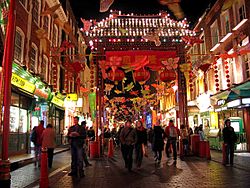East Asian New Year
| East Asian New Year | |
|---|---|
 | |
| Also called | Lunar New Year, Spring Festival, Shōgatsu, Seollal, Tết Nguyên Đán. |
| Observed by | Chinese communities worldwide[1]Japanese, Korean, Vietnamese |
| Type | CultureCultural, Religious (Buddhist, Taoist, Confucian) |
| Significance | The first day of the East Asian lunisolar calendar |
| Celebrations | Lion dances, fireworks, family gathering, family meal, visiting friends and relatives, giving red envelopes |
| Date | Lua error in Module:Wikidata at line 446: attempt to index field 'wikibase' (a nil value). |
| Frequency | annual |
| Related to | First Full Moon Festival, which concludes the celebration of the New Year. |
East Asian New Year is an important traditional holidays in the East Asian cultural sphere. East Asian New Year celebrations traditionally ran from East Asian New Year's Eve, the last day of the last month of the East Asian lunisolar calendar, to the First Full Moon Festival on the 15th day of the first month, making the festival the longest in the traditional East Asian lunisolar calendar. It is often referred to as the "Lunar New Year".
The festival generally falls on the day of the second new moon after winter solstice, unless there is a very rare intercalary eleventh or twelfth month in the lead-up to the New Year. In such a case, the New Year falls on the day of the third new moon after the solstice; the next occurrence of this will be in 2033.It consists of a period of celebrations, starting on New Year's Day. In Japan, prior to the Meiji period, the date of the festival was based on the East Asian lunisolar calendar. However, in 1873, five years after the Meiji Restoration, Japan adopted the Gregorian calendar and the first day of January became the official and cultural New Year's Day. In the Ryukyu Islands, a separate cultural New Year is still celebrated based on the Chinese lunar calendar.
Names[edit]
In China, it is also known as the Spring Festival, the literal translation of the modern Chinese name. Traditionally, the festivities surrounding Chinese New Year was known as the Nian festival (traditional Chinese: 年節; simplified Chinese: 年节; pinyin: Nián Jié), which may be understood to as "festival of the year", or "new year festival". A derivative term, "Guo Nian" (traditional Chinese: 過年; simplified Chinese: 过年; pinyin: guò Nián), "to pass the year", is still commonly used to refer to the act of celebrating the arrival of the new year. An alternative name for Chinese New Year is "New Year in the Agricultural Calendar" (traditional Chinese: 農曆新年; simplified Chinese: 农历新年; pinyin: Nónglì Xīnnían), the "Agricultural Calendar" being one of the more common Chinese language names for the Chinese calendar in China.
The Korean term "Seollal" generally refers to Eumnyeok Seollal (음력 설날, new year), also known as Gujeong (Hangul: 구정; Hanja: 舊正). Less commonly, "Seollal" also refers to Yangnyeok Seollal (양력 설날, solar new year), also known as Sinjeong (Hangul: 신정; Hanja: 新正).
The festival is named "Oshōgatsu" (お正月) in Japan, which means "the first month of the year". After the adoption of the date of Gregorian calendar for the new year, the term "Kyūshōgatsu" (旧正月) is created for the lunar year.
The Vietnamese name of the East Asian New Year is Tết, which is the shortened form of Tết Nguyên Đán. The name Tết Nguyên Đán is Sino-Vietnamese for Feast of the First Morning of the first day, derived from the Hán Nôm characters 節元旦.
Festivities[edit]
Traditionally, the festival was a time to honor deities as well as ancestors.[2] Regional customs and traditions concerning the celebration of the East Asian new year vary widely. Often, the evening preceding East Asian New Year's Day is an occasion for Chinese families to gather for the annual reunion dinner. It is also traditional for every family to thoroughly cleanse the house, in order to sweep away any ill-fortune and to make way for good incoming luck. During the festival, people visiting friends and relatives. Fireworks and lion dance are often available for celebration.
See also[edit]
References[edit]
- ↑ "Asia welcomes lunar New Year". BBC. 2003-02-01. Retrieved 2008-11-07.
- ↑ "Chinese New Year". History. Retrieved February 9, 2013.
This article "East Asian New Year" is from Wikipedia. The list of its authors can be seen in its historical. Articles copied from Draft Namespace on Wikipedia could be seen on the Draft Namespace of Wikipedia and not main one.
